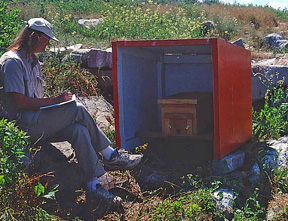How 10,000 bees decide where to go when they fly the coop -- decision-making to rival any department committee
By Susan S. Lang

When 10,000 honeybees fly the coop to hunt for a new home, usually a tree cavity, they have a unique method of deciding which site is right: With great efficiency they narrow down the options and minimize bad decisions.
Their technique, says Cornell University biologist Thomas Seeley, includes coalition building until a quorum develops.
The Seeley group's study, which is published in the May-June issue of American Scientist, might well be used to help improve human group decision-making, he says.
Scientists had known that honeybee scouts "waggle dance" to report on food. Seeley and his colleagues, however, have confirmed that they dance to report on real estate, too, as part of their group decision-making process.
The better the housing site, the stronger the waggle dance, the researchers found, and that prompts other scouts to visit a recommended site. If they agree it's a good choice, they also dance to advertise the site and revisit it frequently. Scouts committed to different sites compete to attract uncommitted scouts to their sites, the researchers have discovered, but because the bees grade their recruitment signals in relation to site quality, the scouts build up most rapidly at the best site.
As soon as 15 or more bees are at any one site, the researchers found, the scouts signal to the waiting bees in the swarm that it's time to warm up their flight muscles in preparation for takeoff. Each scout does so by scrambling through the swarm cluster and briefly pressing its vibrating thorax against the other bees to stimulate them to activate their wing muscles. Once every bee has its thorax warmed to 95 degrees Fahrenheit, the swarm lifts off toward its new home.

"This is a striking example of decision making by an animal group that is complicated enough to rival the dealings of any department committee," said Seeley, a professor of neurobiology and behavior at Cornell and lead author of the article.
For more than 10 years, Seeley, University of California-Riverside entomologist Kirk Visscher (Cornell Ph.D. '85) and Ohio State University engineer Kevin Passino have been observing, videotaping, devising experiments and mathematically modeling honeybee swarms.
"The bees' method, which is a product of disagreement and contest rather than consensus or compromise, consistently yields excellent collective decisions," said Seeley.
When a hive gets too crowded, its queen and half the hive will swarm to a nearby tree and quietly wait while several hundred scouts go house hunting. To explore the decision-making process, the researchers conducted a series of experiments.
To study the waggle dancing for house hunting, the researchers:
- labeled all 4,000 bees in a swarm and recorded the scouts reporting on their site visits. At first, no one site dominated the dancing, but toward the end of the 16-hour decision-making process, one site was advertised much more heavily and eventually became the chosen home.
- offered bees both mediocre and superb nest sites. The better the site, the longer the bees waggle danced -- making 100 circuits for a first-rate site versus 12 for a mediocre one. The swarms almost always chose the excellent site.
To test whether the bees decide by quorum or consensus, the researchers:
- offered swarms two first-rate sites on Appledore Island in the Gulf of Maine, site of Cornell's Shoals Marine Laboratory, both equidistant from the swarm. As soon as about 15 bees were seen at one site, the swarm would take off for it, even though some scouts were still dancing strongly for the other site.
- offered five desirable nests and found that it took much longer for a quorum to develop at any one site, and takeoff took almost twice as long.
To study whether bees always choose the best site, the researchers offered swarms four small and one superior site in size. Although the superior site was never the first one found, it was almost always chosen.
These group decision-making methods, which include an open forum of ideas, frank "discussions" and friendly competition, just might help human committees "achieve collective intelligence and thus avoid collective folly," conclude the researchers.
Whether the quorum-setting method of aggregating independent opinions could substitute for a democratic vote remains to be seen, but it sure could speed up the process toward a swift, but smart, decision, Seeley said.
Get Cornell news delivered right to your inbox.
Subscribe